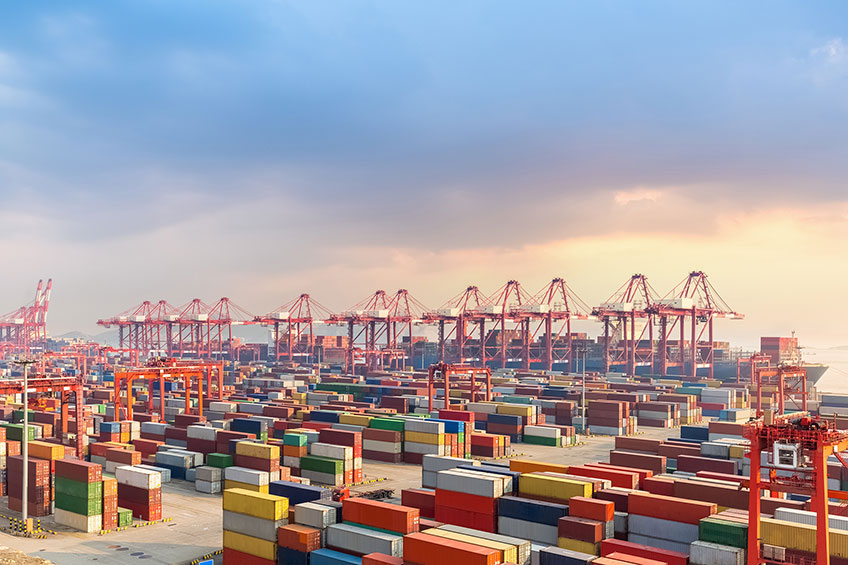April 26, 2022
Electrifying Solution for Container Ports
Time is money: This is probably true for every container port in the world. Increasing automation can reduce not only time and costs but also CO2 emissions. This is demonstrated by a solution from Conductix-Wampfler: The company has developed a system for the automated powering of gantry cranes in container ports, in which the PCV positioning system from Pepperl+Fuchs plays a crucial role.

When the sun rises in the morning and the sky brightens, the air still seems pure and fresh. A deep breath lets the elixir of life flow through your body and gives you renewed energy. But in just a few years' time, the air may not be nearly as clean—and, to be honest, there are already regions and cities where you might prefer not to inhale too deeply. It has never been so urgent to reduce CO2 emissions as it is now. From power plants and industrial facilities to road traffic and even the old fireplace at home—wherever climate-damaging carbon dioxide is emitted, cleaner alternatives are needed for the future. We must not forget the large freight handling sites of our globalized world in the climate debate. Day in, day out, countless containers from all over the world arrive at container port terminals, where they are sorted, stacked, reloaded, and finally sent on their way. Everything must work smoothly to ensure that all goods arrive at their destination on time: 24 hours a day, seven days a week.

Long Distances, Narrow Spaces
The facilities of these container ports are extensive. For example, the world's largest port in Shanghai covers an area of over 3600 ha. This means the distance a container has to travel from where the cargo ship is docked to its place on the port site can be very long. Various vehicles in the port transport the containers to and from the ships. One of the typical means of transport are rubber-tired gantry cranes (RTG). These RTGs bring the containers to their (intermediate) location in container blocks in the port and bring them out again for onward transport. Currently, RTGs are often still powered by diesel engines. This makes them mobile and able to travel around freely, for example, to switch to another container aisle or leave the aisle for maintenance purposes. However, to unload or load a container, RTGs only move forward and backward in the narrow container aisles, which are up to 300 meters long. Despite this great length, space in a container port is scarce, so containers have to be stacked tightly.
Several Birds with One Stone
The company Conductix-Wampfler, which is headquartered in Weil am Rhein in southern Germany, has taken advantage of the limited mobility in container aisles with its solution for electrifying RTGs. A few years ago, the manufacturer of energy and data transfer systems realized there was great potential to reduce CO2 emissions, time, and maintenance costs in the drives of container stacking cranes. The company therefore developed an automated energy supply system. 'Our solution for container ports enables the gantry crane to be supplied with energy from the first row of containers via a contact line, meaning it can be switched from a diesel engine to an electric drive,' explains Armin Schildecker, Project Manager Global E-RTG Projects at Conductix-Wampfler. For this purpose, the contact line is installed on a support profile along the container aisle, while a movable drive-in-unit (DIU) is located on the RTG. When entering the aisle, the DIU docks to the contact line. The container crane is then supplied with power. 'To avoid the need for additional personnel when docking and changing the drive, we developed the system so that this process is fully automated,' says Schildecker. 'To make this possible, we brought Pepperl+Fuchs on board for the required automation components.'

Automation Meets Precision
The PCV (Position Coded Vision) Data Matrix positioning system from Pepperl+Fuchs is an integral part of the solution from Conductix-Wampfler. With IP67 degree of protection and a temperature range of -20 to +60 °C, it can even cope with the ambient conditions of seawater and sea air. 'Our combination of the 2-D camera system and the Data Matrix code tape gives the crucial signal in Conductix-Wampfler's solution and enables automatic switching from diesel engine to electric drive,' explains Timo Hähnert, Sales Engineer at Pepperl+Fuchs. 'The code tape is installed firmly onto the support profile of the energy-carrying contact lines, while the PCV read head is located on the DIU on the gantry crane.' As soon as an RTG enters the container aisle, the 2-D camera system uses event markers to determine which container block the RTG is located in. The system also communicates that the power can now be switched on and the diesel engine switched off. From this point on, the RTG runs purely on electricity. 'The entire process—from entering the container block to continuing with the electric drive—takes less than a minute,' explains Schildecker.
The positioning system not only enables the drive to be switched fully automatically, but also ensures that the RTG is positioned precisely in the aisle. For example, the PCV can help the RTG to move to a predefined position to load or unload a container. 'The automated positioning of the crane makes work on-site considerably easier,' says Schildecker. 'Previously, the relative position between the crane and the container was based on the purely manual work of crane personnel. This work can be greatly simplified with the help of the positioning system. This results in some serious time savings.'

Looking to the Future
Thanks to PCV, the port control center is able to view the exact position of the gantry crane at any time and correlate it with the position of a container. Data is transferred via ProfiDAT®: a data transfer system that reliably transmits video, audio, control, and real-time data with very high data rates and low latency in a slotted waveguide. 'Since data is available in real time, container handling has even been automated to the point that crane drivers no longer have to sit high up in the cab, but can control the RTG easily from the port control center,' explains Schildecker. 'Applications such as autonomous positioning, acceleration, and braking will also be possible using this system in the future.'
To create redundancy for these scenarios, Conductix-Wampfler installs two 2-D cameras on the system solution. 'By using two PCV read heads, we achieve the necessary level of safety here. The Data Matrix positioning system therefore not only enables RTGs to be powered in a more eco-friendly way, but also allows port personnel to control them safely and conveniently via remote control, making their jobs easier,' summarizes Hähnert.
From Individual Customization to Standard Product
The solution from Conductix-Wampfler uses the PCV50 PCV read head, which has been specially adapted for this purpose. Since the container aisles in the port are very narrow, meaning there is very little space available, the distance between the 2-D camera and the code tape had to be very short. The standard reading distance was 80 mm at the time, which was too large for this application. The experts from Pepperl+Fuchs therefore developed the system further for Conductix-Wampfler. 'We adapted our read head with the 2-D camera system so that it is able to read the codes reliably even when very close to the code tape,' says Armin Hornberger, Head of Product Management Industrial Vision at Pepperl+Fuchs. 'The advanced read head is able to capture the codes even at a distance of only 50 mm.' In addition to the shorter reading distance, a PROFINET interface and adapted software were also added. 'Individually customizing the read head has led to it becoming a standard product in our portfolio—and we also optimized our code tape in the process,' reports Hornberger.

As demonstrated with this solution, Pepperl+Fuchs always does everything possible to come up with the perfect solution for any application. If there is no suitable product in the existing portfolio, the automation experts work on a solution until it exactly meets the requirements. Customer-specific solutions like these are principally based on individual consultation and cooperation with the respective customers. "We worked very closely and fruitfully with Pepperl+Fuchs when developing the system solution. The PCV read head was equipped with an extended read range to meet our requirements, and the software was also individually tailored to our application," says Schildecker. "This means the positioning system in our system now fulfills its task optimally, and our customers benefit from significantly higher efficiency and lower CO2 emissions. If you consider how often an RTG travels back and forth during the day, you can quickly see how extensive the savings are and how the overall solution contributes to making container ports more eco-friendly."
Data Matrix Positioning Systems
The Data Matrix positioning systems from Pepperl+Fuchs use an incident light process for precise absolute positioning. They consist of a 2-D camera system, the read head, and a Data Matrix code tape. The self-adhesive code tape is usually attached to a fixed part of the system, while the 2-D read head is mounted on a vehicle that moves parallel to it. Due to code redundancy and a large reading window, the Data Matrix positioning system reliably detects the position even if the code tape is dirty or damaged, and is even able to bridge gaps in the code tape.
Data Matrix Positioning Systems for Camera-Based Linear Positioning

